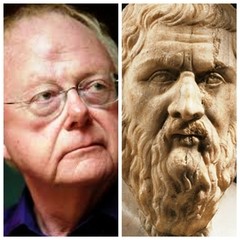|
Back
Ancient Notes in Blazing Colors New York
Peter Jay Sharp Theater, Juilliard School
10/14/2018 -
Oliver Knussen: Two Organa, Opus 27
Igor Stravinsky: Concerto in E flat, “Dumbarton Oaks”
Louis Andriessen: De Staat
Nina Faia Mutlu, Megan Schubert, Jamie Jordan, Melissa Hughes (Voices)
AXIOM, Jeffrey Milarsky (Conductor)

L. Andriessen/Plato
“And don’t throw the past away/You might need it some other rainy day/Dreams can come true again/When everything old is new again”
Peter Allan
For an ensemble and conductor priding themselves on playing contemporary music seamlessly, without an iota of problems...well, AXIOM and Jeffrey Milarsky have a serious question: namely, why did they make everything old new again this Sunday afternoon?
First it was Oliver Knussen, composing cantus firmi back to the 14th Century. Not much better than that was Igor Stravinsky, who gave us his version of a Bach Brandenburg Concerto. But these two were basically babies with Louis Andriessen’s De Staat. Not “the city”, but Plato’s 2,500-year-old Republic. And whatever likes we might have for the first two composers, Mr. Andriessen–present at the performance–had produced some 40 years ago one of the more startling works of the 20th Century.
Listening later on YouTube, it was impossible to reproduce the shattering melange of sounds which Mr. Milarsky summoned up from the unique orchestra. Mr. Andriessen scored this for a quartet of women’s voices, a sextet of violas, two electric and one bass guitar, two harps and two pianos, six trumpets, four oboes and lots of other brass. Nor was he modest in his use of the instruments. De Staat started with four oboes–perhaps the only instrument we know was heard by Plato–added the trombones (which were split over the stage, each player equipped with a bottle of water) and then launched into 30 minutes non-stop orchestral “sections”.
Granted, heard live the four singers in the back of the orchestra were barely heard. The rest of Axiom blared out unrelentingly. No, “blare” is hardly the right word. De Staat went from one orchestral mood to another, yet each section was more and more interesting–even as we recognized stuff which shouldn’t have recognized.
Mainly Stravinsky. Not the Stravinsky of the afternoon’s Dumbarton Oaks, but patterns from Sacre, measure after measure from the more fiery elements of Firebird. When he was off Stravinsky, Mr. Andriessen created sounds of Stan Kenton or Count Basie. Big band sounds, with a hint of jazz (as in his Agamemnon played last week by the New York Philharmonic).
Then we had the repeated tropes, measures played over and over again, like a raucous Steve Reich (or a less than polite mannered Philip Glass).
I will not repeat any of the deep program notes, quoting the composer. They dealt less with the music than the composer’s love-hate relationship with Plato himself! Leonard Bernstein had once tackled Plato in his Symposium, but that was a respectful half-hearted effort. Mr. Andriessen quotes Plato, and despises what Plato wrote about music, about music “changing” society. That may have been true in 1976, but in 2018, Rap has become the very fabric of society, defining not only African-American society but America itself.
Nor does Mr. Andriessen, a Leftist from youth to the age of 79, tackle Plato’s politics, which were blatantly fascist. No need to. For De Staat spoke for itself yesterday. Not as anarchy, not as liberty, not as an anthem or a protest, but a huge quilt with dozens upon dozens of brilliantly painted patterns.
De Staat was, briefly, one of the great events of the new New York season.

J. Milarsky (© Peter Konerko)
Jeffrey Milarsky conducted it with his usual finesse. A percussion player himself, Mr. Milarsky didn’t miss the percussion of the orchestration, for this was a grand enough work of multifarious rhythms and blazoning colors.
The first half began with two tiny jewels by the late enchanted Oliver Knussen. I always felt that Bruno Maderna was the ultimate “colorist” of pre-Renaissance music, but Mr. Knussen, starting with piano and harp together, gave a jewel-like quality to a pair of original medieval styles.
He was a wonder as a composer and (as we heard in Columbia University last year) as a speaker. May he rest in peace.
We’ve had a plethora of Stravinsky these weeks, and the Dumbarton Oaks was given a pleasant enough performance by AXIOM, especially a relatively fiery finale. The composer once stated that he couldn’t relate to Beethoven’s later works, but was always happy to hear the first symphonies and sonatas. Philistine I may be, but after hearing Sacre twice this past month, the Dumbarton Oaks seemed pallid.
Then again, after Mr. Andriessen’s work, nothing but Sacre would make any kind of impression.
Harry Rolnick
|